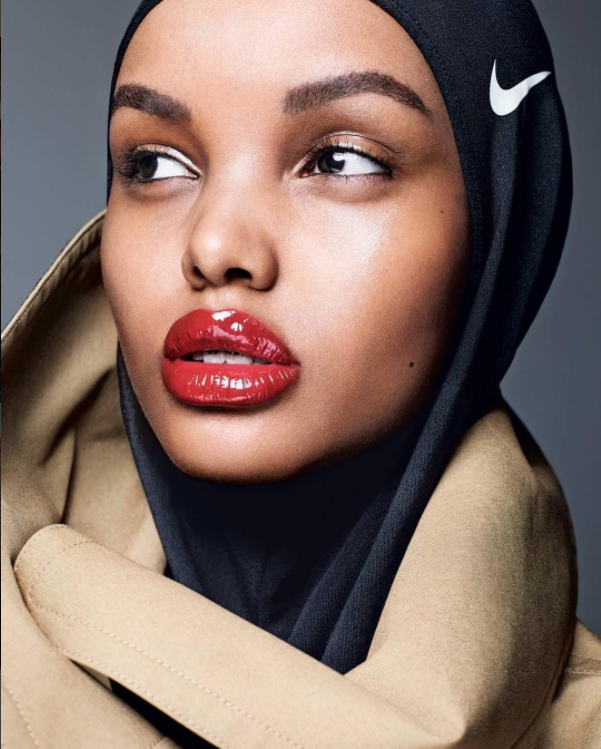Rihanna launched her own makeup collection last week, Fenty Beauty. It features several diverse models, including Halima Aden, who did Kanye West’s Yeezy runway show wearing a hijab and became a semi-finalist in the Miss Minnesota USA pageant. She has since been signed to the IMG Models agency, set to work with numerous designers and brands.
Remember the wide controversy over a Muslim woman posing on the cover of Playboy? This time around there seems to be little concern over a Muslim woman’s association with Rihanna, one of the greatest sex symbols of our time. But I digress.
As a Muslim woman, I cannot get used to the dread I feel when observing the excitement that sparks across Muslim online spaces any time a Muslim woman is recognised by a major company, whether that is a major media outlet or beauty company.
The concept of ‘selling-out’ seems to be absent amongst upcoming Muslim youth celebrities. They fill their Instagram posts with ‘outfit deets’ (see Dina Tokio) and hope that a major company notices them and maybe collaborates with them, or signs them on as a face for the company, or at least signs them as a promoter of their products.
As the Quartz article Millennials are totally cool with selling out unambiguously points out, associating oneself with corporate brands is no longer a form of shame within Western youth subculture. The author rightly explains that unlike generations before them, young people coming of age post 2010 have no idea what the concept even entails: “For millennials, auctioning off our skills and talents to the highest bidder isn’t taboo anymore: It’s mundane, so much so that some of the youngest millennials may not be familiar with the dilemma at all.”
While the piece points to economic factors pressuring millennials into limited financial options, it overlooks the cultural shift in the definitions of success that many young people identify with today. There are numerous viral articles, such as this piece by Huffpost, and this one by The Guardian, discussing studies that highlight the shocking, but not so surprising, revelation that children today want fame more than anything else.
Fame has become an ambition in and of itself. And I do not believe that this has happened because young people have become less valued and more narcissistic.
To understand fame ideals, we need to look at how fame today is framed as a means to empowerment, and as an exercise in leadership. Being famous today is hardly associated with vanity; instead, social capital is an ‘avenue’ to ‘greater access’, to ‘representation’. This is why, now more than ever, it is vital for social justice advocates to call out this toxic fame and social capital culture that is warping youth fervour for change.
I find that every time a Muslim woman wants to provide a kind of cultural or social critique of Muslim women’s involvement in this highly prevalent fame culture, they are dismissed by other Muslims as ‘haram-police’ who don’t know how to have any fun. But the critique is not of the person participating – it’s about the values underpinning their participation. I think it’s necessary to voice concern over the merging of Muslim women’s success with corporate interests.
When I read Malcolm X’s autobiography, I was surprised to come across his fierce condemnation of people he labelled ‘House Negros’ (see his animated speech explaining this here). The most powerful part of it for me was his own confessional storytelling of how, for a part of his youth, he wanted nothing more than approval and access to middle-class black networks, in closer proximity to whiteness. From subjecting himself to the excruciating pain of smoothing his hair, to changing his fashion sense, to having a preference for dancing with and dating a white girl, parading her across town as status trophy, Malcolm X takes us through a personal encounter that helps us navigate our own conflicting relationship with our colonised mindset.
What stands out to me is how easy and natural it was for Malcolm X to go down this initial path. Among his peers, and within the subculture he belonged to, these were markers of success. Just as young Muslim women today are redefining success in proximity to whiteness, under the spotlight of famous women of colour such as Rihanna.
Today, whiteness has redefined itself through corporate brands and social media markers of popularity that do not necessarily look or act white, but nevertheless solidify white supremacy.
It is important to pause and consider how a singer like Rihanna, with a diverse model cast, could be accused of affirming whiteness in her brand when she deliberately works to undo exactly this.
Think about the online discussion that’s been happening over the past two weeks regarding what some cultural media analysts have dubbed the ‘Asian hair streak’ trope. Picked up by Buzzfeed, basically the question is: Why are so many Asian female characters depicted with a coloured streak in their hair?
One explanation suggested by the Twitter user who brought this to light seems to generally be that “the designers pigeon-hole the Asian or East Asian girl into one extreme or the other… the demure, gentle, subservient Asian housewife or the rebellious girl”.
Rihanna’s brand basically works in a similar way, advancing a ‘rebellious woman of colour’ trope that sells empowerment through commodification. One of the models featured in the launch video, Leomie Anderson, called Fenty “the beauty brand for girls who know who the fuck they are and aren’t afraid to show it!”
Of course, we celebrate the move away from objectifying and passive notions of femininity that appease the white male gaze, but this shift should not be at the expense of further burdening women of colour with arguably even more stringent stereotypes as ‘ideals’ to meet, instead of old ‘oppressed girl’ stereotypes to challenge.
Women of colour are more widely practicing empowerment through ‘talking back’, whether this is through visual storytelling in the form of YouTube videos or Instagram poetry. Muslim women are creating their own media platforms, like Muslim Girl, and writing their own fictional stories, extending the voices of Muslim women into research through narrative and storytelling methodologies.
Our social media feeds are flooded with images and ‘stories’ by Muslim women, but what would make these subversive as opposed to performing for the appeasement of the white gaze and consumerist interests would be if they functioned more as counter-stories, serving to critique existing institutions and social structures. The purpose should be to develop empathy for those whose stories are otherwise sidelined, and to commit to the well-being of the tellers of otherness.
That’s the difference between an image that tries to tell us a radical, alternative truth, and a vanity pose of a pretty-looking girl. One should not be conflated into the other. Counter-storytelling should be able to ‘redirect the dominant gaze, to make it see from a new point of view what has been there all along’ (Taylor, 2009, p. 8).
Women of colour evolve, and as their politics changes, so do the stories they tell and the mediums they use to tell them. Award-winning author and social justice advocate Randa Abdel-Fattah has spoken on this, explaining that when she was younger, she would speak back to racism and try to prove her humanity. She encourages young people to make their own spaces, away from racism and stereotypes. To create their counter-stories.
While amplifying the voices of Muslim women is a noble mission no doubt, we need to be careful that we don’t confuse fame and raising awareness, such as the type that comes with visibly Muslim models like Fenty Beauty’s Halima Aden, with actual action. It is important for our racial justice objectives to distinguish between storytelling and counter-storytelling. I admire the leadership of women who commit themselves to the advancement of the voices of women of colour, such as in Amani Al-Khatahtbeh’s appearance on Q&A, showing a charismatic willingness to stand up against pressures to pigeonhole her responses during interviews.
I hope that her politics transcends its performative attraction, to motivate us towards a full commitment to challenging the western powers that do regard us as inferior. The packaging of commercialised empowerment as social justice work only works to undermine actual bloody, dangerous and unglamorous commitment to political transformation.
At the end of the day, we have to pick a side: do we want to be on billboards, or do we want to dismantle power structures?
Cover image © Halima Aden, via Instagram
About the author
Tasnim Sammak is a PhD student at the Faculty of Education, Monash University (Clayton). She's a spokesperson and founder of Solidarity for Palestine - Narrm, Melb.



